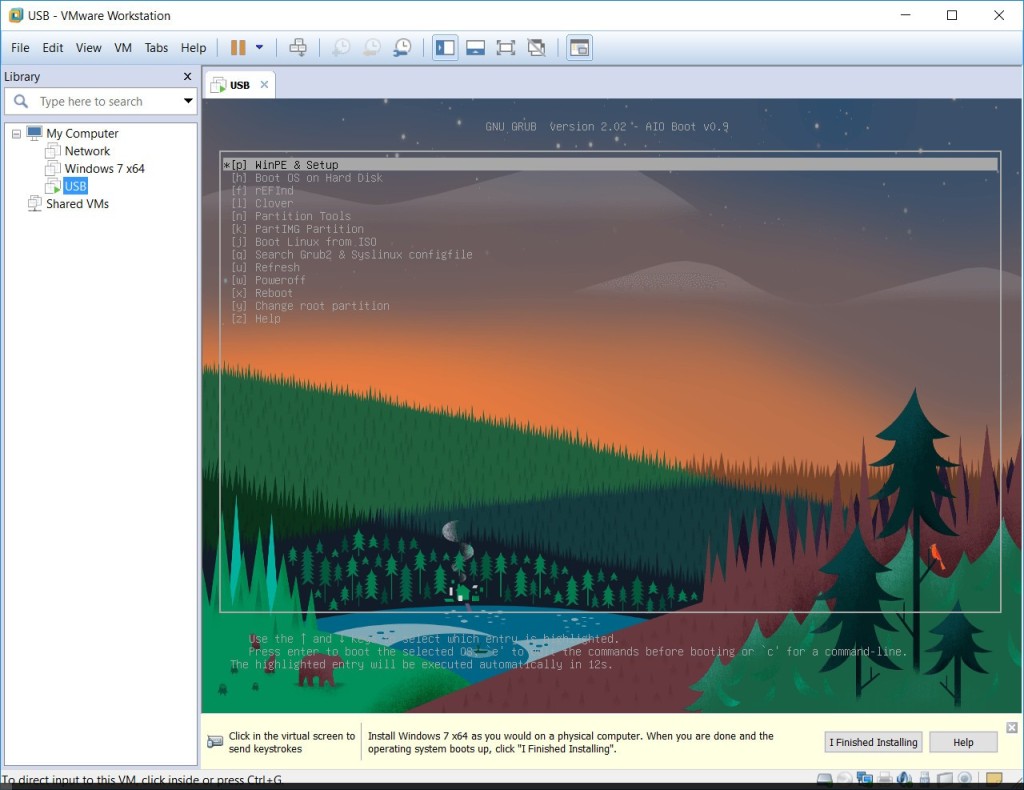Vmware Boot From Usb
Section 1: Boot a Virtual Machine from USB on VMware Section 2: Boot a Virtual Machine from CD/DVD(ISO Image) on VMware After successfully booting virtual machine from USB/CD, you will be able to run OS or programs from USB/CD to install/reinstall/repair Windows system, or reset Windows password on VMWare workstation.
Computer Type: LaptopSystem Manufacturer/Model Number: MS Surface Pro 3OS: Windows 10 Pro 64-bitCPU: Intel Core i5 4300U @ 1.9Haswell ULT 22nm TechnologyMotherboard: MS SP3Memory: 8.00GB Dual-Channel DDR3 (12-15-15-34)Graphics Card: Intel HD Graphics Family (Microsoft)Sound Card: Realtek High Definition AudioMonitor(s) Displays: Generic PnP Monitor (2160x1440@59Hz)Screen Resolution: 2160x1440Keyboard: Detachable BacklitMouse: Surface Arc TouchHard Drives: 238GB Hitachi HFS256G3AMNB-2200A (SSD)Internet Speed: WiFi -45MB/sBrowser: FF,ChromeAntivirus: MBAM, Defender,SASOther Info: Pen. No one cares about this. What we want is to put our install media on usb and use that to create a vm instead of just selecting a iso. This should of addressed by them YEARS ago.What are you rabbiting on about? That is exactly what the new feature will do.I cannot see any real point to it anyway, as all installation media are in downloadable iso format, and why bother tying up a usb stick and usb port anyway to install an OS on a VM.
What is point of virtualising a PC if you don't virtualise everything?Even if you got a usb drive installation drive, and no iso, it takes a couple of minutes to create an iso anyway.In the end, this is a solution to a problem we never had! What are you rabbiting on about? That is exactly what the new feature will do. I cannot see any real point to it anyway, as all installation media are in downloadable iso format, and why bother tying up a usb stick and usb port anyway to install an OS on a VM. What is point of virtualising a PC if you don't virtualise everything? Even if you got a usb drive installation drive, and no iso, it takes a couple of minutes to create an iso anyway.
In the end, this is a solution to a problem we never had!you're clueless aren't you? It's a way to test a key before actually using it as you install media. Yes it's rare for the media to fail while you are installing windows but it does happen, and this makes it possible to verify that the media will work as it should. And fyi his post says boot a vm not a iso from external usb. No one cares about this. What we want is to put our install media on usb and use that to create a vm instead of just selecting a iso.


This should of addressed by them YEARS ago.Hi thereI'm the foreigner here but I thought my English was clear enough - Boot whatever OS is on the USB - I don't mean run VMWARE workstation and open a VM that's stored on an external USB drive.I mean when you get into the VM's Virtual BIOS on VMware player select Boot into Firmware and then you can select as the boot device a USB drive / stick and boot whatever OS is on it. Until recently you could only give a real CD/ DVD device or an ISO image as one of the alternative boot options as well as the Virtual HDD or a network card (PXE).Sorry if my English wasn't clear enough.Cheersjimbo. You're clueless aren't you? It's a way to test a key before actually using it as you install media. Yes it's rare for the media to fail while you are installing windows but it does happen, and this makes it possible to verify that the media will work as it should.
Vmware 15 Boot From Usb
And fyi his post says boot a vm not a iso from external usb.You are the clueless one.Read Jimbo's reply. There is no need to have that ability JUST for testing a usb stick is working. In fact that is not the best way to test it at all. A far better way is to create a virtual hard drive and install to that!
How To Boot From Usb Windows 10
Hi thereI'm the foreigner here but I thought my English was clear enough - Boot whatever OS is on the USB - I don't mean run VMWARE workstation and open a VM that's stored on an external USB drive.I mean when you get into the VM's Virtual BIOS on VMware player select Boot into Firmware and then you can select as the boot device a USB drive / stick and boot whatever OS is on it. Wpa elcomsoft wireless security auditor commview. Until recently you could only give a real CD/ DVD device or an ISO image as one of the alternative boot options as well as the Virtual HDD or a network card (PXE).Sorry if my English wasn't clear enough.CheersjimboIt was clear to me but I did initially ask if it worked for usb flash drives, as Hyper-v can boot from usb hard drives but not normal usb removable flash drives as you cannot take them offline. You say in your reply it can - I assume you have done it?